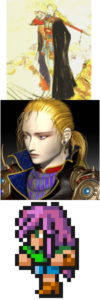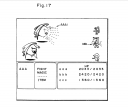Final Fantasy VI: Bridging the Gap
Usually, when I play a series of games, I play them in order of release, even if that means suffering through the crummy ones before I get to the ones everyone raves about. Final Fantasy has been an exception, and that provides me a rare opportunity to observe the earlier ones with full knowledge of where things were heading. FF6 is a bridging element in my experience of the series: I’ve already played FF5 and FF7. And it’s interesting to me to see the ways it fits a niche halfway between those two games.
As I’ve commented before, the setting of FF5 seemed to be a medieval veneer over advanced industrial technology. The designers wanted to use submarines and force fields and interplanetary travel, but they still wanted to present it as basically a standard pre-industrial fantasy gameworld with castles and dragons and so forth, so the high tech came off as somewhat incongruous and anachronistic. In FF7, this was reversed: the swords-and-sorcery stuff was the anachronism in a setting that’s basically modern and even futuristic in places. Now, FF6 still has castles and kings, but the idea of technology substituting for magic is central to the premise, so they can’t try to sweep it all under the rug without comment the way FF5 did. On the contrary: whenever there’s technology around, which there frequently is, the characters essentially keep saying “Look! Technology!” One of those kings is a playable character, and also a gadgeteer who’s fitted out his castle with all the latest things, including engines for burrowing into the sand and traveling underground.
The character system also has aspects of both FF5 and FF7. Like the former, you have job skills: only the thief can steal things in combat, only the gadgeteer I just mentioned can use clockpunk contraptions, etc. Like the latter, character class is inextricably bound to individual characters, and each “class” has exactly one character in it. Class doesn’t really mean all that much in FF7, though, since the function of job skills — the main thing the whole Job system was used for — is taken over by Materia. The characters differ only in their base stats, what kinds of equipment they can use, and their “limit breaks”, the special attacks that you only get to use after taking a lot of damage. FF6 seems to have a proto-limit break system. At least, the manual claims that characters can make more powerful attacks when they’re low on health. I haven’t observed this myself, because it’s hard to keep a character low on health long enough for them to make an attack: any enemy group capable of reducing someone to that state is probably also capable of finishing them off unless you provide massive healing at the earliest opportunity. I suppose this is why the designers altered the rules when they made FF7. (“Has taken a lot of damage” is not the same as “is currently low on health”, and is a much easier state to achieve.)
I can’t say much about the plot at this early stage, but so far it’s revolved around an “Esper”, a being of great magic, discovered embedded in a crystal in a mine. The empire wants it, and the player characters don’t want them to have it. After a while, it essentially hatches from its mineral shell and somehow merges with the party’s magic specialist, Terra, who transforms into something other than human and flies away. This could be seen as FF5‘s defend-the-crystals plot combined with the FF7‘s business about Jenova, a powerful alien being discovered underground, whose living cells were injected into humans in a super-soldier project. Or is that too much of a stretch?
 Comments(1)
Comments(1)
